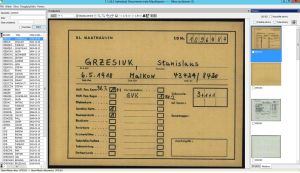Select Pages
The Arolsen Archives (former International Tracing Service – ITS) in Bad Arolsen was established to search for and register missing persons during World War II. From the beginning of its activity, even during the war, it collected various types of documents regarding people repressed by the Third Reich, which today constitute a powerful resource consisting of 26 km of files. For over a decade, these materials have been digitized, which allows access to collections via a specially constructed database.
The Institute of National Remembrance is the only institution in Poland, and one of several in the world, which has the full version of this unique application. Obtaining it was possible thanks to the accession of the Republic of Poland, as the only country from the former Eastern Bloc, to the Bonn Agreements, which took place on 7 March 2000, and as a result of their amendment of 16 May 2006, when it was decided to make available ITS digital copies to the signatories of the treaty. In 2007, the Ministry of Foreign Affairs of the Republic of Poland decided to transfer digitized materials to the Institute of National Remembrance in Warsaw, while the archivists of the Institute began to use them in 2010.
The database is divided thematically into three parts. The first - Incarceration and Persecution is a collection of camp, prison, investigation and court materials. The camp files that form the basis of this section mostly refer to individual concentration camps. Particularly noteworthy are the collections regarding KL Dachau, KL Buchenwald and KL Mauthausen – camps of which original documentation has been preserved to a large extent. We mainly deal with scans of prisoner cards, transport lists of people arriving and leaving the camp, lists of the imprisoned in labour commandos, death certificates or materials from camp hospitals.
Gestapo documentation, prison and forensic materials were collected in the Prisons and Persecution subset. We will find here, among others, police files, prosecutorial documentation and court proceedings, as well as prison records.
The second part of the documentation contained in the database (Registration of Foreigners and German Persecutees by Public Institutions, Social Securities and Companies) is a collection of materials regarding persons registered and employed in the Reich territory, mainly foreign forced labourers. An important part of the collection are lists of people residing in individual municipalities in Germany during the war, drawn up in the post-war years by order of the Allied occupation authorities.
They were drafted based on the original local documentation - police, prison, registration or medical records. One can also find here registers of the deceased and information about burial places. The second part contains original documents drawn up during the war - work cards, registration cards, personal cards of prisoners of war. They are supplemented by post-war materials of registry offices regarding persons remaining on the territory of Germany and Austria (marriage, birth, death certificates).
The third part (Registrations and Files of Displaced Persons, Children and Missing Persons) are mainly materials recording the fate of the so-called displaced persons (DPs), i.e. people who were outside their homeland after World War II, mainly in the former Reich. These documents contain information about their stay in transit camps, help received and finally repatriation or emigration. The third part also contains documentation of the office dealing with finding missing children during the war, e.g. taken away from parents and placed in Lebensborn facilities, as well as help for orphaned children located in Germany.
The application contains records relating to the fate of over 17,000,000 people, and the digitized Arolsen Archives central personal file, which is the basis for searching the database. It contains about 50,000,000 cards.
